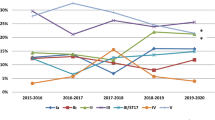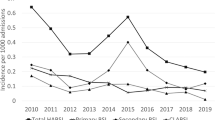Abstract
OBJECTIVE: To assess the “real-world” compliance with risk- and culture-based strategies to prevent early-onset group B streptococcal disease.
STUDY DESIGN: We retrospectively reviewed the medical records of consecutive term pregnancies delivered at three institutions (a subset of practices at an academic hospital using the culture-based strategy, an academic hospital using the risk-based strategy, and a community hospital using both) between January and March 1998. We abstracted demographic data and risk factors for group B streptococcus, group B streptococcal culture information, documentation of intrapartum antibiotic prophylaxis, and adverse drug reactions. We compared intrapartum compliance with the intended strategy.
RESULTS: There were a total of 505 women managed with the risk-based strategy. Of those, 79 had a risk factor for group B streptococcal disease and 72/79 (91.1%) received intrapartum antibiotic prophylaxis. There were a total of 428 women managed with the culture-based strategy. Of those, 70 had positive cultures and 67 (95.7%) received intrapartum antibiotic prophylaxis. An additional 39 women in the culture-based group had no documentation that cultures had been done. Of those, eight (20.5%) had risk factors and all eight received intrapartum antibiotic prophylaxis. Compliance with the risk-based strategy was 91.1 versus 96.2% with the culture-based strategy (p=0.3). Among women managed using the risk-based strategy, 5/426 (1.2%) received intrapartum antibiotic prophylaxis without an identifiable risk factor. Among women in the culture-based strategy, 5/359 (1.4%) received intrapartum antibiotic prophylaxis with documented negative group B streptococcal cultures (p=0.5). When examined by site, compliance with the intended strategy was 91.2% at the academic hospital using the risk-based strategy, 100% at the academic hospital using the culture-based strategy, 90.9% at the community practices using the risk-based strategy, and 82.4% at the community practices using the culture-based strategy.
CONCLUSION: Overall, intrapartum compliance with the risk-based approach was similar to the culture-based approach. However, there were more cultures not done and cultures done at inappropriate gestations at the community hospital practice.
This is a preview of subscription content, access via your institution
Access options
Subscribe to this journal
Receive 12 print issues and online access
$259.00 per year
only $21.58 per issue
Buy this article
- Purchase on Springer Link
- Instant access to full article PDF
Prices may be subject to local taxes which are calculated during checkout
Similar content being viewed by others
References
Schrag SJ, Phil D, Zywicki S, et al. Group B streptococcal disease in the era of intrapartum antibiotic prophylaxis. N Engl J Med 2000;342:15–20.
Boyer KM, Gadzala CA, Burd LI, et al. Selective intrapartum Chemoprophylaxis of Neonetal Group B Streptococcal Early-Onset Disease. Epidemologic Rationale. J Infect Dis 1983;148:795–801.
Carstensen H, Christensen KK, Grennert L, Persson K, Polberger S . Early-onset neonatal group B streptococcal septicemia in siblings. J Infect 1988;17:201–4.
Persson K, Bjerre B, Elfstrom L, Polberger S, Forsgren A . Group B streptococci at delivery: high count in urine increases risk for neonatal colonization. Scand J Infect Dis 1986;18:525–31.
Wood EG, Dillon Jr. HC . A prospective study of group B streptococcal bacteruria in n. Am J Obstet Gynecol 1981;140:515–20.
Baker CJ, Kasper DL . Correlation of maternal antibody deficiency with susceptibility to neonatal group B streptococcal infection. N Engl J Med 1976;294:753–6.
Boyer KM, Gotoff SP . Prevention of early-onset neonatal group B streptococcal disease with selective intrapartum chemoprophylaxis. N Engl J Med 1986;314:1665–9.
American College of Obstetricians and Gynecologists Committee on Obstetric Practice. Prevention of Early-Onset Group B Streptococcal Disease in Newborns. Washington: The College; 1996.
Prevention of perinatal group B streptococcal disease: a public health perspective. Centers for Disease Control and Prevention [published erratum appears in Morb Mortal Wkly Rep 1996;45(31):679. Morb Mortal Wkly Rep 1996;45(RR-7):1-24.
Watt JP, Schuchat A, Erickson K, et al. Group B streptococcal disease prevention practices of obstetrician-gynecologists. Obstet Gynecol 2001;98:7–13.
Lieu TA, Mohle-Boetani JC, Ray GT, et al. Neonatal group B streptococcal infection in a managed care population. Perinatal Group B Streptococcal Infection Study Group. Obstet Gynecol 1998;92:21–7.
Factor SH, Levine OS, Nassar A, et al. Impact of a risk-based prevention policy on neonatal group B streptococcal disease. Am J Obstet Gynecol 1998;179:1568–71.
Schrag SJ, Zell ER, Lynfield R, et al. A population-based comparison of strategies to prevent early-onset group B streptococcal disease in neonates. N Engl J Med 2002;347:233–9.
Cheon-Lee E, Amstey MS . Compliance with the Centers for Disease Control and Prevention antenatal culture protocol for preventing group B streptococcal neonatal sepsis. Am J Obstet Gynecol 1998;179:77–9.
Hafner E, Sterniste W, Rosen A, et al. Group B streptococci during pregnancy: a comparison of two screening and treatment protocols. Am J Obstet Gynecol 1998;179:677–81.
Main EK, Slagle T . Prevention of early-onset invasive neonatal group B streptococcal disease in a private hospital setting: the superiority of culture-based protocols. Am J Obstet Gynecol 2000;182:1344–54.
Yancey MK, Schuchat A, Brown LK, Ventura VL, Markenson GR . The accuracy of late antenatal screening cultures in predicting genital group B streptococcal colonization at delivery. Obstet Gynecol 1996;88:811–5.
Pearlman MD, Pierson CL, Gaix, RG . Frequent resistance of clinical group B streptococci isolates to clindamycin and erythromycin. Obstet Gynecol 1998;92:258–61.
Morales WJ, Pickey SS, Bornick P, Lim DV . Change in antibiotic resistance of group B streptococcus: impact on intrapartum management. Am J Obstet Gynecol 1999;181:310–4.
Centers for Disease Control and Prevention. Prevention of perinatal group B streptococcal disease. Morb Mortal Wkly Rep 2002;51(RR-11):1–22.
Author information
Authors and Affiliations
Rights and permissions
About this article
Cite this article
Riley, L., Appollon, K., Haider, S. et al. “Real World” Compliance With Strategies to Prevent Early-Onset Group B Streptococcal Disease. J Perinatol 23, 272–277 (2003). https://doi.org/10.1038/sj.jp.7210895
Published:
Issue Date:
DOI: https://doi.org/10.1038/sj.jp.7210895
This article is cited by
-
Prevention of Group B Streptococcus early-onset disease: a toolkit by the California Perinatal Quality Care Collaborative
Journal of Perinatology (2010)
-
Prevention of Early-onset GBS Sepsis: Evaluation of a Changing Paradigm
Journal of Perinatology (2003)



